I'm looking for references on Medieval sword scabbards - What are appropriate scabbard features for any given sword type or era?
Are there any references specific to Medieval sword scabbards?
It's easy to buy a sword, but then choosing an appropriate "period" scabbard is not so easy.
For example:
Is a metal chape appropriate for an Oakeshott Type XI sword?
When should you have a thong instead of a buckle for a sword belt?
Is an integrated belt more appropriate, or a strap suspension?
When is a metal locket and ring suspension more appropriate than wrapped leather straps?
Have you ever seen tooling on an extant leather scabbard?
Here is a thread where someone else is asking as similar question:
http://www.myArmoury.com/talk/viewtopic.php?t=24846
Do a Google search on "myArmoury scabbards" and see how many times other people have asked similar questions about scabbards for a specific sword or time period.
I have gone through numerous Oakeshott books (and other books), browsed online museum collections, searched illuminated manuscripts, looked at a lot of effigies, etc. It's a lot of work, if you've ever done that sort of research.
I'm wondering if anyone has ever thoroughly researched that matter and published a document or a guide to Medieval sword scabbards.
Or are we all reinventing the wheel every time we want to make a period-appropriate scabbard? Maybe doing the research is half the fun?
Thnx
If there is such a comprehensive reference I've spent an awful lot of time and money for no good reason. I've got literally dozens of reference books that deal with small slices of time, and I'm reasonably confident that I'm still missing detailed information on some pretty good chunks of history... and that some of the information I do have is not completely accurate.
On the other hand I've been considering writing a book...
On the other hand I've been considering writing a book...
| Russ Ellis wrote: |
| If there is such a comprehensive reference I've spent an awful lot of time and money for no good reason. I've got literally dozens of reference books that deal with small slices of time, and I'm reasonably confident that I'm still missing detailed information on some pretty good chunks of history... and that some of the information I do have is not completely accurate.
On the other hand I've been considering writing a book... |
I know I would be interested in that book Russ. I have always liked going to your site and wishing I could afford one of your scabbards.
Here is a example of what I am talking about. This is from my research on 12th Century swords (Oakeshott XI-XIa swords). Please add corrections and comments, if you can. I am slowly working on similar data for other sword types.
SWORD BELTS
Sword belts of the 12th Century (corresponding to Oakeshott XI and XIa swords) are all wide, white or very light in color (buckskin?) and fastened by knotted thongs (figure 1). The belts are undecorated and do not have any mounts. However, one illustration from the late 12th Century shows a white sword belt with a linear array of round dots (figure 2).
[ Linked Image ]
Figure 1: A typical 12th Century sword belt. It is made of a wide, lightly-colored leather and fastened by knotting a thong.
[ Linked Image ]
Figure 2: A linear array of dots on a wide white sword belt (Germany, AD 1168-1189).
Curiously, one illumination from 12th Century Italy shows soldiers carrying their scabbards hanging from their forearms (figure 3). This could represent soldiers rushing into battle before they had time to put on the belts.
[ Linked Image ]
Figure 3: All four soldiers with scabbards hanging from their forearms (Italy, AD 1100-1200).
SWORD SUSPENSION SYSTEMS
The white sword belts are always integrated (laced) into the scabbard. The integrated white straps are laced in an "X" or backwards "Z" pattern (figure 4). Sometimes the tails are knotted on the outside of the scabbard and the tails hang like tassels (figure 4, right).
[ Linked Image ]
Figure 4: Typical "X" or backwards "Z" lacing patterns on 12th Century scabbards. the image on the right shows the hanging tassels.
SCABBARDS
Presumably 12th Century scabbards are covered with leather, generally dark brown. Rarely the scabbards appear to be the same light color as the white belt. No other colors were seen, although many illustrations are in black and white. Integrated rain guards and metal chapes do not appear in illuminations until late in the 12th Century (figures 5 and 6). The chapes are all simple. Other features, such as leather tooling, risers, rings and lockets, are not found on 12th Century scabbards in the illuminated manuscripts.
[ Linked Image ]
Figure 5: Integrated rain guards on late 12th Century scabbards (Germany, AD 1180-1200).
[ Linked Image ]
Figure 6: A simple metal chape on a late 12th Century scabbard (Spain, AD 1197).
SWORD BELTS
Sword belts of the 12th Century (corresponding to Oakeshott XI and XIa swords) are all wide, white or very light in color (buckskin?) and fastened by knotted thongs (figure 1). The belts are undecorated and do not have any mounts. However, one illustration from the late 12th Century shows a white sword belt with a linear array of round dots (figure 2).
[ Linked Image ]
Figure 1: A typical 12th Century sword belt. It is made of a wide, lightly-colored leather and fastened by knotting a thong.
[ Linked Image ]
Figure 2: A linear array of dots on a wide white sword belt (Germany, AD 1168-1189).
Curiously, one illumination from 12th Century Italy shows soldiers carrying their scabbards hanging from their forearms (figure 3). This could represent soldiers rushing into battle before they had time to put on the belts.
[ Linked Image ]
Figure 3: All four soldiers with scabbards hanging from their forearms (Italy, AD 1100-1200).
SWORD SUSPENSION SYSTEMS
The white sword belts are always integrated (laced) into the scabbard. The integrated white straps are laced in an "X" or backwards "Z" pattern (figure 4). Sometimes the tails are knotted on the outside of the scabbard and the tails hang like tassels (figure 4, right).
[ Linked Image ]
Figure 4: Typical "X" or backwards "Z" lacing patterns on 12th Century scabbards. the image on the right shows the hanging tassels.
SCABBARDS
Presumably 12th Century scabbards are covered with leather, generally dark brown. Rarely the scabbards appear to be the same light color as the white belt. No other colors were seen, although many illustrations are in black and white. Integrated rain guards and metal chapes do not appear in illuminations until late in the 12th Century (figures 5 and 6). The chapes are all simple. Other features, such as leather tooling, risers, rings and lockets, are not found on 12th Century scabbards in the illuminated manuscripts.
[ Linked Image ]
Figure 5: Integrated rain guards on late 12th Century scabbards (Germany, AD 1180-1200).
[ Linked Image ]
Figure 6: A simple metal chape on a late 12th Century scabbard (Spain, AD 1197).
Last edited by Harry Marinakis on Sat 21 Dec, 2013 6:05 pm; edited 1 time in total
This is not really a reference, but at least a sort of antique source. Violet Le Duc’s Dictionnaire raisonné du mobilier français de l'époque Carolingienne à la Renaissance Tome Cinquieme has a handful of sketches of swords with scabbards that he produced during the mid 1800’s, based upon antiquities (or replicas.. I can only guess what he saw at that time.) A sketch or two was around page 195-197, and a few others near the folios in the 370's. There are close to 500 pages with unrelated sketches of other objects just in that volume.
 Attachment: 203.16 KB
Attachment: 203.16 KB
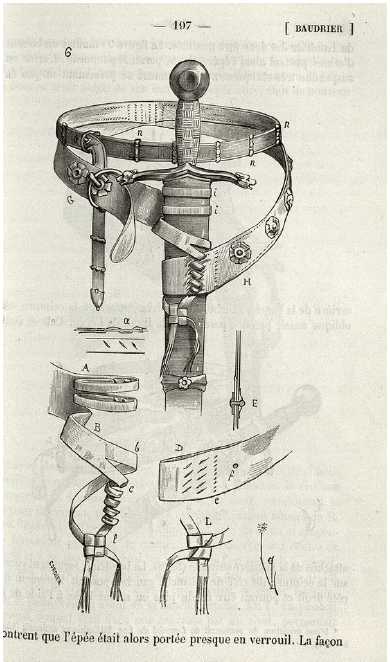
 Attachment: 205.73 KB
Attachment: 205.73 KB
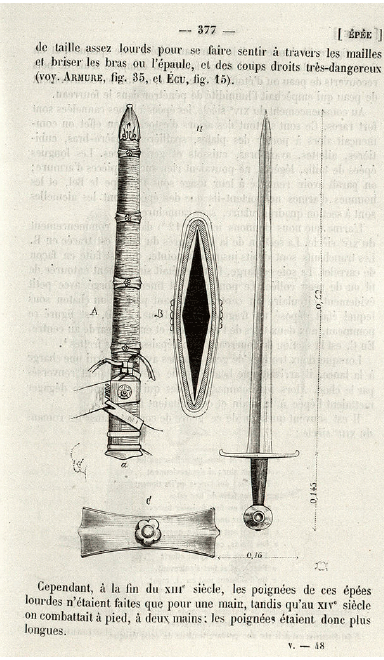


If there were even a halfway comprehensive scabbard book I would buy it in a heartbeat. In the meanwhile, I've been looking up some primary sources to inspire my late 14th century kit, so I put together an album focusing on that range (with quite a bit of leeway). It's not much but that period can be really tricky when it comes to detail so hopefully it helps.
Notes to approximate date, location or original source can be found in the file description for each image.
http://tinyurl.com/n3y3jgj
The OP asked some questions I'd love to know more about, too. Particularly the type and level of tooling for different periods.
Notes to approximate date, location or original source can be found in the file description for each image.
http://tinyurl.com/n3y3jgj
The OP asked some questions I'd love to know more about, too. Particularly the type and level of tooling for different periods.
The medieval period lasts for roughly 1000 years, from the end of antiquity to the Renaissance. Are you looking at scabbards for the whole of that period?
I can help you with stuff for the first 500 years as I am attempting to catalog every example from Western Europe between the late 4th century.to the 11th and I've reconstructed quite a few of them.
I can help you with stuff for the first 500 years as I am attempting to catalog every example from Western Europe between the late 4th century.to the 11th and I've reconstructed quite a few of them.
| Scott Kowalski wrote: | ||
I know I would be interested in that book Russ. I have always liked going to your site and wishing I could afford one of your scabbards. |
Hey Scott,
Thank you for the kind words, I'm still learning, hence all the books! :) Shoot me a line sometime, we can talk.
| Matthew Bunker wrote: |
| The medieval period lasts for roughly 1000 years, from the end of antiquity to the Renaissance. Are you looking at scabbards for the whole of that period?
I can help you with stuff for the first 500 years as I am attempting to catalog every example from Western Europe between the late 4th century.to the 11th and I've reconstructed quite a few of them. |
That's certainly a monumental effort in and of itself. Are you confining yourself to archeaological finds or also considering period art etc? Either way, if you publish the book I'll buy yours! :)
| Russ Ellis wrote: |
| Are you confining yourself to archeaological finds or also considering period art etc? |
Both where possible, although I'm only really using art to inform reconstructions where the use/arrangements of scabbard fittings is unclear.
I too would love this fictional book! So who is going to take this job on?
Matthew - put me down for a signed copy.......
Harry Marinakis wrote
Veg tan leather is a pale skin colour when undyed and this can be decorated easily as it can be moulded and stamped and otherwise formed.
Alum tanned leather is white (I know there was some symbolic knight thing about white belts that I now forget) and I am not saying with certainty that the belts were alum tanned, but as a side issue it cannot be tooled or stamped effectively so that may explain a lack of decoration if this leather was in use for this application. The scabbard shown here has a belt made in alum tanned leather https://www.facebook.com/media/set/?set=a.10151271046391776.454547.336997521775&type=3 .
When you think of buckskin, I assume you are thinking of the Native North American product and I suspect that the colour is related to the tanning method which was 'brain tanned' I believe and this method as far as I know was not widespread in western Europe.
Anyway, I suspect that the belts were alum tanned cow/ox and white.
Tod
Matthew - put me down for a signed copy.......
Harry Marinakis wrote
| Quote: |
| Sword belts of the 12th Century (corresponding to Oakeshott XI and XIa swords) are all wide, white or very light in color (presumably made of buckskin) and fastened by knotted thongs (figure 1). The belts are undecorated and do not have any mounts. However, one illustration from the late 12th Century shows a buckskin sword belt with a linear array of round dots (figure 2).
|
Veg tan leather is a pale skin colour when undyed and this can be decorated easily as it can be moulded and stamped and otherwise formed.
Alum tanned leather is white (I know there was some symbolic knight thing about white belts that I now forget) and I am not saying with certainty that the belts were alum tanned, but as a side issue it cannot be tooled or stamped effectively so that may explain a lack of decoration if this leather was in use for this application. The scabbard shown here has a belt made in alum tanned leather https://www.facebook.com/media/set/?set=a.10151271046391776.454547.336997521775&type=3 .
When you think of buckskin, I assume you are thinking of the Native North American product and I suspect that the colour is related to the tanning method which was 'brain tanned' I believe and this method as far as I know was not widespread in western Europe.
Anyway, I suspect that the belts were alum tanned cow/ox and white.
Tod
Last edited by Leo Todeschini on Sat 21 Dec, 2013 12:55 pm; edited 1 time in total
Harry,
What North Americans tend to describe as "buckskin" - a buttery to golden colour is oil or brain tanned, as Tod mentioned. Skin of deer and sheep don't make good belt leather as it tends to be stretchy. Buff leather was very common for straps and belts as it doesn't stretch although it is oil tanned bovine leather. (ox or cow) It also might be almost white and easily whitened as desired. Tawed leather might be used for dressy things but requires significant maintenance in outdoor use as alum is readily soluable in water. A day in the rain can wash out a lot of alum, potentially ruining the piece.
Tod is right, modern thin vegetable tanned leather, be it calf or goat, is the best choice for tooling and dyeing decorative items like belts and scabbards. It also takes top coatings like oil or wax very well.
What North Americans tend to describe as "buckskin" - a buttery to golden colour is oil or brain tanned, as Tod mentioned. Skin of deer and sheep don't make good belt leather as it tends to be stretchy. Buff leather was very common for straps and belts as it doesn't stretch although it is oil tanned bovine leather. (ox or cow) It also might be almost white and easily whitened as desired. Tawed leather might be used for dressy things but requires significant maintenance in outdoor use as alum is readily soluable in water. A day in the rain can wash out a lot of alum, potentially ruining the piece.
Tod is right, modern thin vegetable tanned leather, be it calf or goat, is the best choice for tooling and dyeing decorative items like belts and scabbards. It also takes top coatings like oil or wax very well.
Great info.
I posted an inquiry on this forum a while back regarding the white color of 12th C belts and the answer I got was "buckskin." I think it back before the database crash.
So you think the white sword belts that are so ubiquitous in 12th C images are alum tanned leather? What weight of leather do you think they used for those belts?
Thanks again!
I posted an inquiry on this forum a while back regarding the white color of 12th C belts and the answer I got was "buckskin." I think it back before the database crash.
So you think the white sword belts that are so ubiquitous in 12th C images are alum tanned leather? What weight of leather do you think they used for those belts?
Thanks again!
Just a technical point, if a skin has been prepared with alum, then it is tawed, not tanned.
The previous discussion on white belts is here:-
http://www.myArmoury.com/talk/viewtopic.php?t=13560&view=next
The previous discussion on white belts is here:-
http://www.myArmoury.com/talk/viewtopic.php?t=13560&view=next
The scabbard of Infante Fernando de la Cerde supposedly has "buckskin" strapping.
[ Linked Image ]
 Attachment: 58.35 KB
Attachment: 58.35 KB
[ Download ]
[ Linked Image ]
[ Download ]
I had been referred to chapter 5 "Grip and Scabbard" in Oakeshott's book The Sword in the Age of Chivalry.
This is all Oakeshott has to say about scabbards (it is the very last paragraph in the above chapter):
"Rather than waste space in making detailed comments on these variations [in scabbard fashions], let the medieval artist do here what is bests done by him anywhere: show for himself what sort of mounts were in use between c. 1100 and 1500 (figures 167, 17, 21, 43, 70, 81, 82, 101, 117, 118, 120, 125)."
:evil:
This is all Oakeshott has to say about scabbards (it is the very last paragraph in the above chapter):
"Rather than waste space in making detailed comments on these variations [in scabbard fashions], let the medieval artist do here what is bests done by him anywhere: show for himself what sort of mounts were in use between c. 1100 and 1500 (figures 167, 17, 21, 43, 70, 81, 82, 101, 117, 118, 120, 125)."
:evil:
| Quinn W. wrote: |
| If there were even a halfway comprehensive scabbard book I would buy it in a heartbeat. In the meanwhile, I've been looking up some primary sources to inspire my late 14th century kit, so I put together an album focusing on that range (with quite a bit of leeway). It's not much but that period can be really tricky when it comes to detail so hopefully it helps.
Notes to approximate date, location or original source can be found in the file description for each image. http://tinyurl.com/n3y3jgj The OP asked some questions I'd love to know more about, too. Particularly the type and level of tooling for different periods. |
I appreciate the pictures, I didnt' have some of those.
A member just asked me about great sword scabbards of the 13th and 14th centuries. Not my period, but I'm pretty handy with ImaReal by now, so I turned up these illustrations. Not all are clearly longer swords, but there are good views of scabbard and suspension treatment. Should be of benefit to all who are interested in the period.
These are clustered around 1330-1350, with a few in the 1200s and a couple in the late 1300s. One detail to notice is that some chapes were asymmetrical--longer on one side than the other, not unlike the drag on modern saber scabbards.
These are German/Austrian.
 Attachment: 179.88 KB
Attachment: 179.88 KB
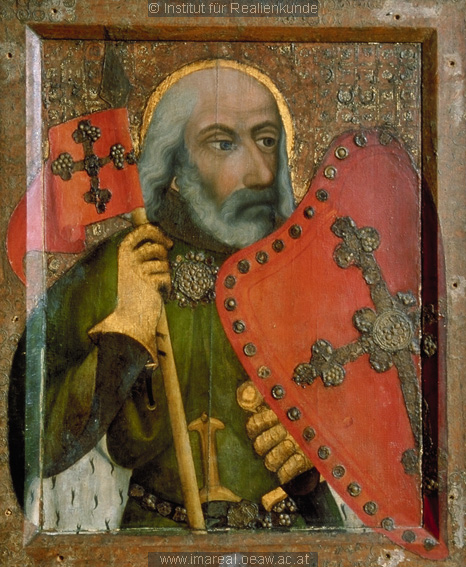
 Attachment: 192.69 KB
Attachment: 192.69 KB
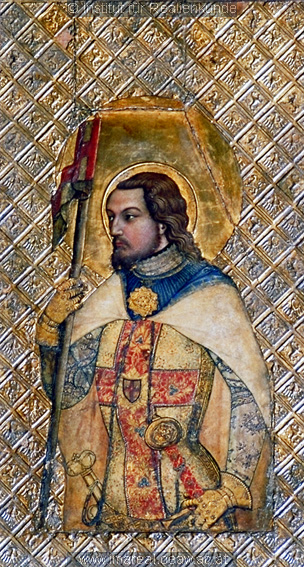
 Attachment: 209.06 KB
Attachment: 209.06 KB
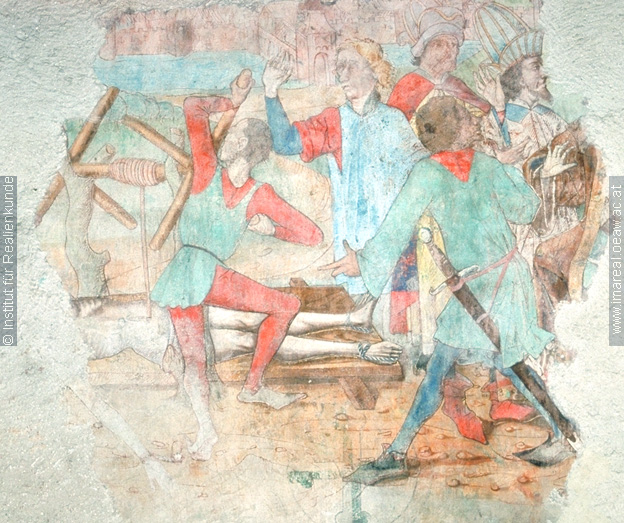
 Attachment: 214.54 KB
Attachment: 214.54 KB
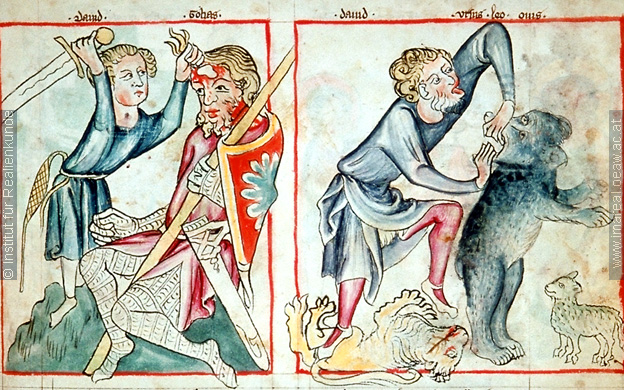
 Attachment: 199.64 KB
Attachment: 199.64 KB
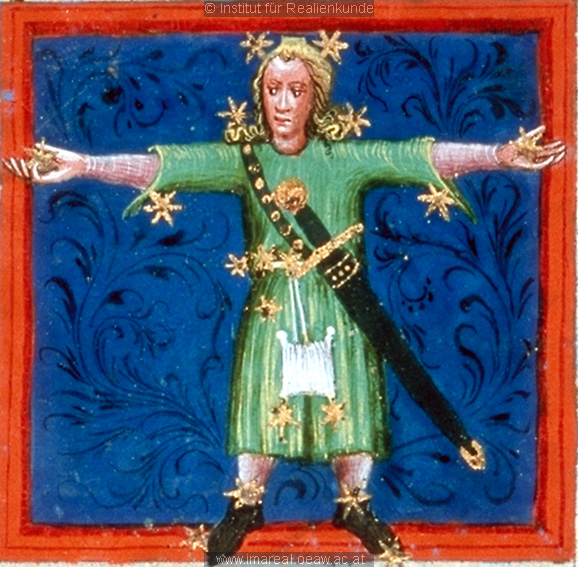
 Attachment: 236.78 KB
Attachment: 236.78 KB
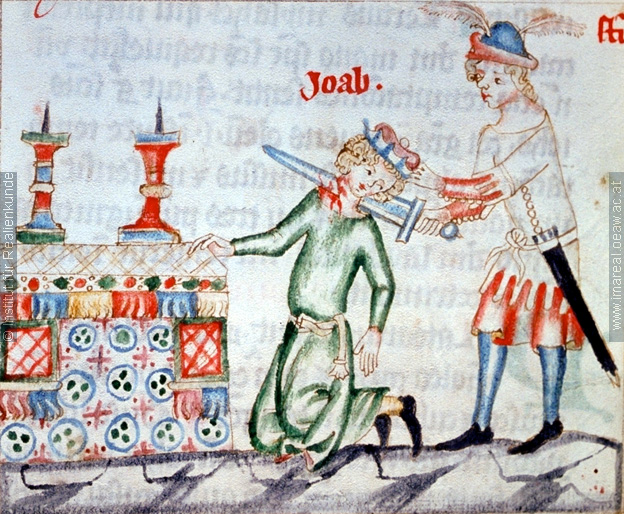
 Attachment: 224.52 KB
Attachment: 224.52 KB
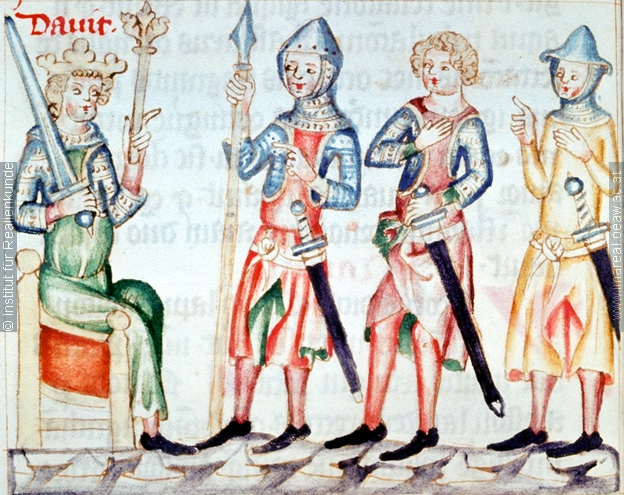
 Attachment: 239.96 KB
Attachment: 239.96 KB
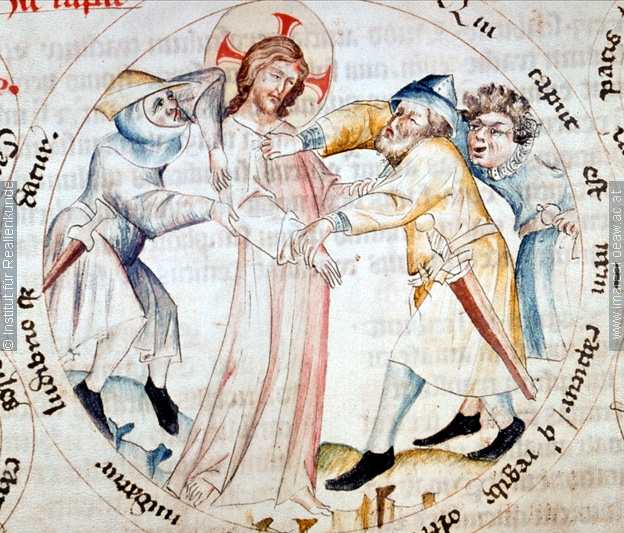
These are clustered around 1330-1350, with a few in the 1200s and a couple in the late 1300s. One detail to notice is that some chapes were asymmetrical--longer on one side than the other, not unlike the drag on modern saber scabbards.
These are German/Austrian.








This one probably comes closest to answering my correspondent's main question, as it appears to be a sword of long grip if not blade, and it shows great detail in the untied belt.
 Attachment: 195.32 KB
Attachment: 195.32 KB
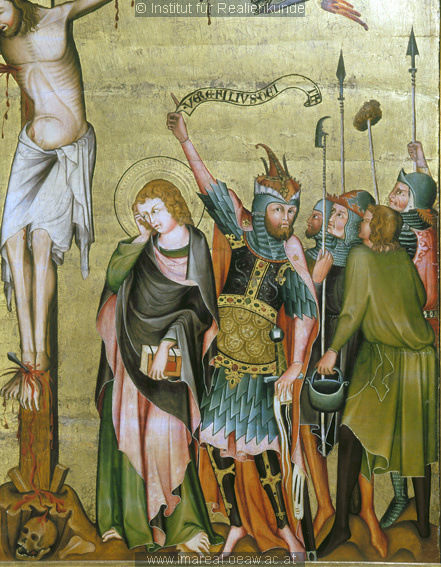
 Attachment: 199.13 KB
Attachment: 199.13 KB
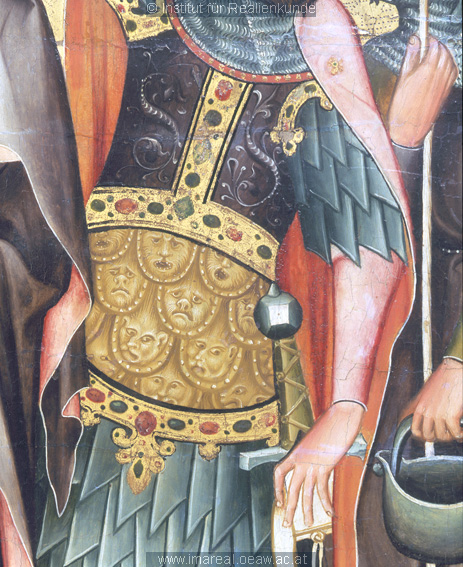


Thanks Sean, the more the merrier!
Page 1 of 1
You cannot post new topics in this forumYou cannot reply to topics in this forum
You cannot edit your posts in this forum
You cannot delete your posts in this forum
You cannot vote in polls in this forum
You cannot attach files in this forum
You can download files in this forum
All contents © Copyright 2003-2006 myArmoury.com — All rights reserved
Discussion forums powered by phpBB © The phpBB Group
Switch to the Full-featured Version of the forum
Discussion forums powered by phpBB © The phpBB Group
Switch to the Full-featured Version of the forum